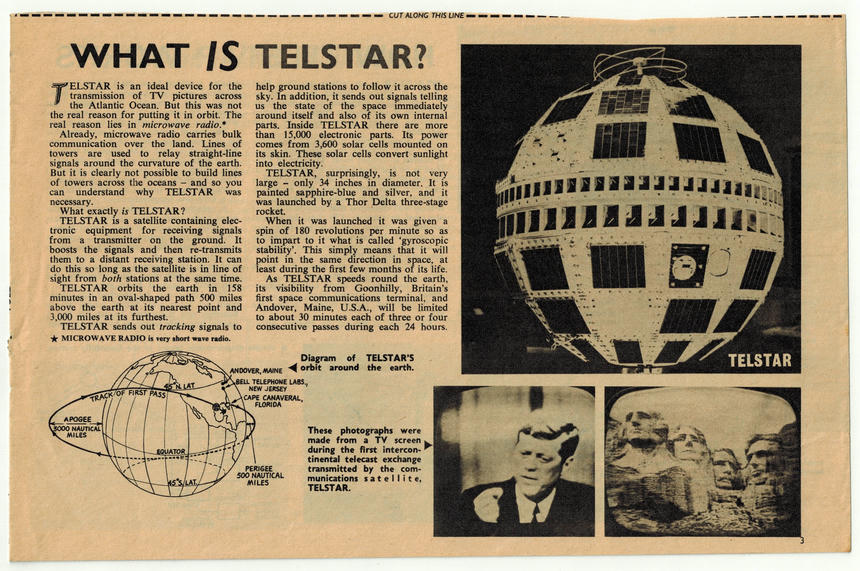Scrapbook 3: The Story of Telstar (3)

WHAT IS TELSTAR?
TELSTAR is an ideal device for the transmission of TV pictures across the Atlantic Ocean. But this was not the real reason for putting it in orbit. The real reason lies in microwave radio.*
Already, microwave radio carries bulk communication over the land. Lines of towers are used to relay straight-line signals around the curvature of the earth. But it is clearly not possible to build lines of towers across the oceans — and so you can understand why TELSTAR was necessary.
What exactly is TELSTAR?
TELSTAR is a satellite containing electronic equipment for receiving signals from a transmitter on the ground. It boosts the signals and then re-transmits them to a distant receiving station. It can do this so long as the satellite is in line of sight from both stations at the same time.
TELSTAR orbits the earth in 158 minutes in an oval-shaped path 500 miles above the earth at its nearest point and 3,000 miles at its furthest.
TELSTAR sends out tracking signals to help ground stations to follow it across the sky. In addition, it sends out signals telling us the state of the space immediately around itself and also of its own internal parts. Inside TELSTAR there are more than 15,000 electronic parts. Its power comes from 3,600 solar cells mounted on its skin. These solar cells convert sunlight into electricity.
TELSTAR, surprisingly, is not very large — only 34 inches in diameter. It is painted sapphire-blue and silver, and it was launched by a Thor Delta three-stage rocket.
When it was launched it was given a spin of 180 revolutions per minute so as to impart to it what is called ‘gyroscopic stability’. This simply means that it will point in the same direction in space, at least during the first few months of its life.
As TELSTAR speeds round the earth, its visibility from Goonhilly, Britain’s first space communications terminal, and Andover, Maine, U.S.A., will be limited to about 30 minutes each of three or four consecutive passes during each 24 hours.
* MICROWAVE RADIO is very short wave radio.
Diagram of TELSTAR’S orbit around the earth.
These photographs were made from a TV screen during the first intercontinental telecast exchange transmitted by the communications satellite, TELSTAR.